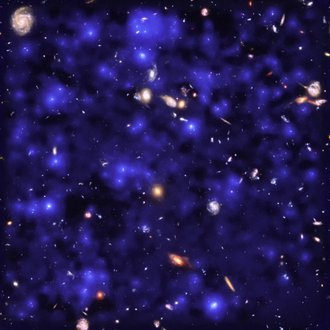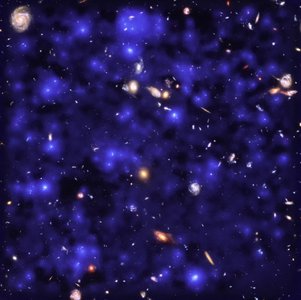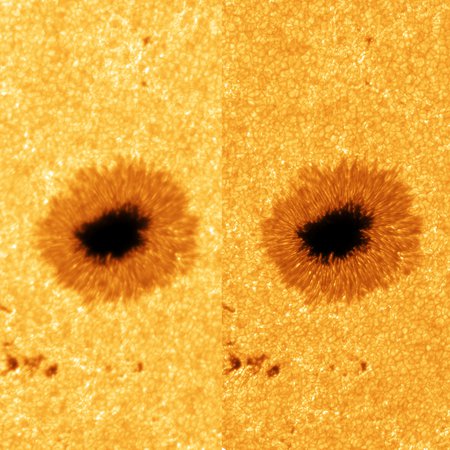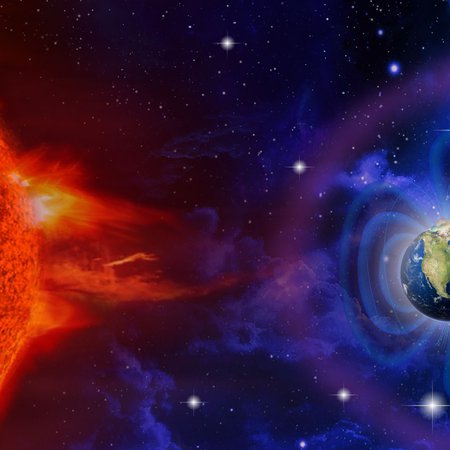The glowing Universe

Deep observations made with the MUSE spectrograph on ESO’s Very Large Telescope have uncovered vast cosmic reservoirs of atomic hydrogen surrounding distant galaxies.
Credit: ESO/L. WisotzkiUsing the MUSE spectrograph at the Very Large Telescope of the European Southern Observatory (ESO), scientists have uncovered vast cosmic reservoirs of atomic hydrogen surrounding distant galaxies. The international team led by Lutz Wisotzki, Professor of Observational Cosmology at the Leibniz Institute for Astrophysics Potsdam (AIP) and the University of Potsdam, observed for the first time how far such luminous hydrogen clouds extend into space. The researchers now report on this in the current issue of "Nature".
Light travels astonishingly quickly, but at a finite speed, meaning that the light reaching Earth from extremely distant galaxies took a long time to travel, giving us a window to the past, when the Universe was much younger. As a result, the signals that can be received by such galaxies are correspondingly faint – this requires the world's largest telescopes with the best sensors to obtain usable data. MUSE, the instrument behind these latest observations, is a state-of-the-art integral field spectrograph installed at ESO's Paranal Observatory in Chile and partly developed and built by AIP. When MUSE observes the sky, it sees the distribution of wavelengths in the light striking each pixel in its detectors. Looking at the full spectrum of light from astronomical objects provides us with deep insights into the astrophysical processes occurring in the universe.
Of particular interest to astrophysicists is the light of the so-called Lyman-alpha spectral line, which is generated by cosmic hydrogen. Based on the MUSE observations of Lyman-alpha radiation from distant galaxies, the research team was able to prove that the hydrogen is not only to be found within the galaxies as expected, but that they are surrounded by very extensive hydrogen envelopes. Although the detected radiation is extremely faint, it is distributed so widely that practically every direction in the sky shows at least the outer area of such a hydrogen shell.
“Realising that the whole sky glows in optical when observing the Lyman-alpha emission from distant clouds of hydrogen was a literally eye-opening surprise,” explaines AIP scientist and team member Dr Kasper Borello Schmidt.
The observed region is an otherwise unremarkable area in the constellation of Fornax ("the Furnace"). In 2004 it was first mapped by the Hubble Space Telescope. Those observations revealed thousands of galaxies scattered across a dark sky, giving an impressive view of the universe. Thanks to MUSE, a closer look into this region was now possible. The study published in the journal Nature shows for the first time how this "cosmic glow" from the gas pockets of the earliest galaxies is distributed in the light of the Lyman-alpha radiation.
"With these MUSE observations, we get a completely new view on the diffuse gas 'cocoons' that surround galaxies in the early Universe," commented co-author Philipp Richter.
The spectacular discovery of the astronomers proves that such clouds of hydrogen exist and that they glow - albeit incredibly weak. However, the exact physical processes leading to the emission of this radiation are still not fully understood. But as the team has now shown, it is ubiquitous in the night sky, and future research is expected to shed light on its origin.
“In the future, we plan to make even more sensitive measurements,” concluded Lutz Wisotzki, leader of the team. “We want to find out the details of how these vast cosmic reservoirs of atomic hydrogen are distributed in space.”
Further information
Publication
http://dx.doi.org/10.1038/s41586-018-0564-6
ESO press release
https://www.eso.org/public/news/eso1832/
Nature shareable link
arXiv publication
https://arxiv.org/abs/1810.00843s
Contacts University of Potsdam
Scientific Contact
Professor Philipp Richter, 0331-977 1841, prichter@astro.physik.uni-potsdam.de
Media Contact
Antje Horn-Conrad, 0331-977 1665, hconrad@uni-potsdam.de
Images
Deep observations made with the MUSE spectrograph on ESO’s Very Large Telescope have uncovered vast cosmic reservoirs of atomic hydrogen surrounding distant galaxies.
Big screen size [1000 x 995, 120 KB]
Original size [2154 x 2145, 490 KB]



